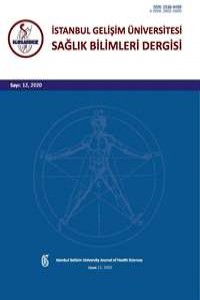Research Article
Year 2020,
Issue: 12, 357 - 364, 29.12.2020
Abstract
Amaç: Bu çalışmada postkoital kanama şikâyeti ile gelen hastalarda servikal sitolojinin preinvaziv veya invaziv servikal patolojilerin tespit edilmesindeki güvenilirliğini araştırmak ve aşırı kanama, anormal sitoloji durumlarındaki yönetim şeklini belirlemek amaçlanmıştır.
Yöntem: İstanbul Eğitim ve Araştırma Hastanesi’ne postkoital kanama şikâyeti ile başvuran ve servikal sitoloji ve kolposkopi yapılan 178 hasta retrospektif olarak smear sonucu normal olanlar ve smear sonucu anormal olanlar olarak 2 gruba ayrılmıştır.
Bulgular: Biyopsi sonuçları hem gruplar arasında hem de menopozda olup olmamalarına göre karşılaştırıldı. PAP smear için preinvaziv ve invaziv patoloji açısından sensitivite ve spesifisite hesaplanmıştır.
Sonuç: Postkoital kanama şikâyeti ile müracaat eden hastalarda gözle görünür bir lezyona sahip olmayan ve smear sonucu negatif olan grupta kolposkopi yapmak anlamlı değildir. Aşırı kanaması olan ya da PAP smear sonucu anormal olan ya da servikste lezyonu olan hastalarda mutlaka kolposkopik muayene ve biyopsi yapılması gerekmektedir.
Keywords
References
- Shapley M, Jordan J, Croft PR. A systematic review of postcoital bleeding and risk of cervical cancer. Br J Gen Pract. 2006;56(527):453- 60.
- Tarney CM, Han J. Postcoital bleeding: a review on etiology, diagnosis, and management. Obstetrics and gynecology international. 2014;27(122):78-79.
- Tehranian A, Rezaii N, Mohit M, Eslami B, Arab M, Asgari Z. Evaluation of women presenting with postcoital bleeding by cytology and colposcopy. Int J Gynaecol Obstet. 2009;105:18-20.
- Selo-Ojeme DO, Dayoub N, Patel A, Metha M. A clinico-pathological study of postcoital bleeding. Arch Gynecol Obstet. 2004;270:34-6.
- Luesley D, Leeson S. Colposcopy and programme management. Guidelines for the NHS cervical screening programme. NHSCSP Publication. 2004;20:28-32.
- Goldstein RB, Bree LR, Benson CB, et al. Evaluation of the woman with postmenopausal bleeding: society of radiologists in ultrasound-sponsored consensus conference statement. Journal of Ultrasound in Medicine. 2001;(10):1025–1036.
- Viikki M, Pukkala E, Hakama M. Bleeding symptoms and subsequent risk of gynecological and other cancers. Acta Obstet Gynecol Scand. 1998;77(5):564-9.
- Pretorius R, Semrad N, Watring W, Fotheringham N. Presentation of cervical cancer. Gynecol Oncol. 1991;42(1):48-53.
- Torre LA, Bray F, Siegel RL, Ferlay J, Lortet‐Tieulent J, Jemal A. Global cancer statistics, 2012. CA: A Cancer Journal For Clinicians, 2015;65(2):87-108.
Year 2020,
Issue: 12, 357 - 364, 29.12.2020
Abstract
Aim: Our primary aim is to investigate the efficacy of cytology to detect preinvasive and/or invasive cervical pathologies in patients with postcoital bleeding and our secondary aim is to determine the management of postcoital bleeding with severe bleeding, abnormal cytology and normal cytology.
Methods: 178 patients who applied to Istanbul Training and Research Hospital with the complaint of postcoital bleeding and underwent cervical cytology and colposcopy were retrospectively divided into 2 groups: with normal smear (Group 1) and with abnormal smear (Group 2).
Results: Biopsy results were compared between both groups and menopausal status. Sensitivity and specificity of pap smear were calculated for preinvasive and invasive pathology.
Conclusion: In the total patient group, it was observed that the highest rate of invasive cancer was in group without smear due to severe bleeding (Group 1), and lowest rate was in group with normal cytology (Group 2). Colposcopy is unnecessary without visible lesion and with negative smear. However, colposcopic examination and biopsy are necessary for patients with bleeding during the examination or with abnormal smear results.
Keywords
References
- Shapley M, Jordan J, Croft PR. A systematic review of postcoital bleeding and risk of cervical cancer. Br J Gen Pract. 2006;56(527):453- 60.
- Tarney CM, Han J. Postcoital bleeding: a review on etiology, diagnosis, and management. Obstetrics and gynecology international. 2014;27(122):78-79.
- Tehranian A, Rezaii N, Mohit M, Eslami B, Arab M, Asgari Z. Evaluation of women presenting with postcoital bleeding by cytology and colposcopy. Int J Gynaecol Obstet. 2009;105:18-20.
- Selo-Ojeme DO, Dayoub N, Patel A, Metha M. A clinico-pathological study of postcoital bleeding. Arch Gynecol Obstet. 2004;270:34-6.
- Luesley D, Leeson S. Colposcopy and programme management. Guidelines for the NHS cervical screening programme. NHSCSP Publication. 2004;20:28-32.
- Goldstein RB, Bree LR, Benson CB, et al. Evaluation of the woman with postmenopausal bleeding: society of radiologists in ultrasound-sponsored consensus conference statement. Journal of Ultrasound in Medicine. 2001;(10):1025–1036.
- Viikki M, Pukkala E, Hakama M. Bleeding symptoms and subsequent risk of gynecological and other cancers. Acta Obstet Gynecol Scand. 1998;77(5):564-9.
- Pretorius R, Semrad N, Watring W, Fotheringham N. Presentation of cervical cancer. Gynecol Oncol. 1991;42(1):48-53.
- Torre LA, Bray F, Siegel RL, Ferlay J, Lortet‐Tieulent J, Jemal A. Global cancer statistics, 2012. CA: A Cancer Journal For Clinicians, 2015;65(2):87-108.
There are 9 citations in total.
Details
| Primary Language | Turkish |
|---|---|
| Subjects | Clinical Sciences |
| Journal Section | Research Article |
| Authors | |
| Publication Date | December 29, 2020 |
| Acceptance Date | November 25, 2020 |
| Published in Issue | Year 2020 Issue: 12 |
![]() Attribution-NonCommercial-NoDerivatives 4.0 International (CC BY-NC-ND 4.0)
Attribution-NonCommercial-NoDerivatives 4.0 International (CC BY-NC-ND 4.0)

